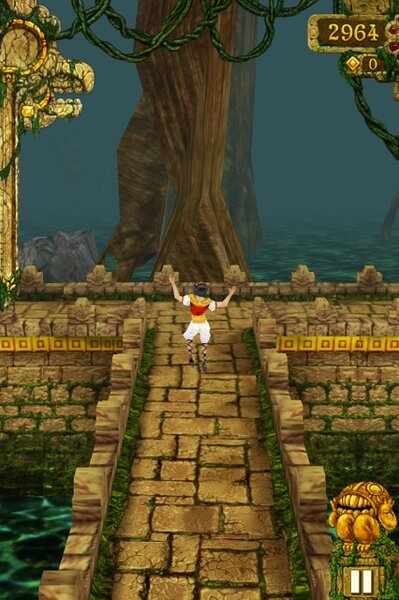Temple Run for Android proves that 'free' can be profitable
Almost all successful video games share one thing in common: They pair in-depth game play with stunning graphics. Last year’s Call of Duty: Modern Warfare 3 combined player customization, varying scenarios, tight controls, and explosive visuals worthy of a summer popcorn flick. The game made $400 million on its opening day, selling 9 million copies in November alone.
But that cardinal rule of $60 Xbox games doesn't apply to iPhone and Android. In the blossoming world of mobile games, success is much less predictable. Cutting-edge graphics are nice, but hardly necessary. In-depth game play is often scrapped for a single, well-realized idea. And at least one app has made a fortune by giving away its app for free.
Temple Run, developed by Imangi Studios’ designer-couple Natalia Luckyanova and Keith Shepherd, hit 36 million downloads in February, according to the company. That’s 36 million downloads on just iPhone and iPad – the game was released for Android on Tuesday. Temple Run features Guy Dangerous, “just your average explorer,” running from a band of polygonal demon monkeys through an endless, twisting jungle path.
The objective is to collect coins, grab power-ups, and stay alive – a call back to the days of the original Super Mario Bros. So how is a game with such a simple premise holding its own in the era of Modern Warfare 3, which has a six-hour story and 16 multiplayer arenas? There are countless iPhone games with simple premises and rudimentary graphics. What is it about Temple Run that resonates?
For one thing, games such as Temple Run are perfect in terms of the smart-phone mentality – they’re quick, easy, versatile, and don’t take much thought. Whip out your iPhone, play for 30 seconds and go about your day, or sit on the couch and enjoy a longer session. This isn’t the case for Modern Warfare or other games featuring elongated campaigns, all of which require conscious effort and time.
Guy Dangerous follows a singular path – albeit, one that has more than a few twists and turns – but nonetheless, it’s far from a 360-degree, 3-D view. Users only have to swipe left, right, up, or down, or slightly tilt their phones in order to grab coins in hard-to-reach areas.
Needless to say, the graphics aren’t superb. In fact, they’re reminiscent of Nintendo 64 games from 1996 (only at a higher resolution). Back then, fun meant collecting yellow coins and improving your score with each run. Temple Run capitalizes on the idea of simple competition – there’s nothing better than informing your friends that you have earned the “2.5 Million Club” badge (inspiring them to whip out their phones and play their way back to the high score). Runs take about one to two minutes, so it doesn’t take too long to snag 2.5 million points once you’ve got the controls down. It’s good, old-fashioned fun.
This vintage nature of Temple Run’s gameplay is appealing both to gamers and less video-game savvy players. It isn’t the only made-for-phone, points-based game that’s seeing success without attempting to mirror console games. Bejeweled Blitz, Poker by Zynga, Tetris, and Words with Friends have stayed high on the App Store charts for months. They compete with more heavy-duty opponents such as Grant Theft Auto 3, a mobile version of the 10-year-old console blockbuster. The app version performed well day-one but quickly disappeared.
Why? It stands to reason that not everyone who buys a mobile game is looking for the cutting edge. Those who are willing to shell out $60 for the premiere, eight- to 20-hour video games are in a league of their own. That being said, smart phones are becoming more and more popular and cost-friendly. Temple Run’s enormous success throws into question whether developers like Rockstar, the company behind Grand Theft Auto, can bridge the gap and appeal to millions of smart-phoners who aren’t necessarily looking to play a complicated game on the way to work.
Temple Run makes a great first impression because it’s, well, free. That was a savvy decision by the creators, not an act of kindness. The game was first sold for $0.99 in the App Store, but Luckyanova and Shepherd decided to remove the price tag when they weren’t seeing many downloads. This proved to be a wise decision – revenue quintupled. After the change, more people downloaded the app, got hooked, and decided to spend money on paid extras, including additional characters and power-ups. Add-ons become more useful as you try to beat your high score. Luckyanova and Shepherd capitalized on the idea that players would be less hesitant to throw money at a game that they learned to love than one they weren’t sure they would like.
As developers such as Rockstar attempt to jump on the games-for-phones bandwagon, the question remains – is it possible to beat the addicting simplicity of a Temple Run using old tricks? Can a TV-game mindset create a dynamite commuter game? As phones evolve, we can expect to see improvements in graphics and play modes. But the outcome lies with the consumer. Do people want their phones to be fully video-game functional, or is Temple Run a good compromise for on-the-go gamers?
For now, it looks as if console games will be console games, and mobile games will remain – well, mobile. Sure, there’s been some amount of integration, especially with tablets. But for now, Temple Run is the latest in mindless mobile entertainment.
For more tech news, follow us on Twitter @venturenaut. And don’t forget to sign up for the weekly BizTech newsletter.






